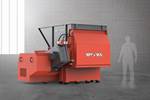PC Copolymers with Exceptional Chemical Resistance
SABIC has expanded its LNP CRX with four new grades for healthcare and consumer electronics applications.

Four new grades have been added by SABIC to its portfolio of exceptionally chemically-resistant LNP CRX PC copolymer resins for healthcare and consumer electronics applications. These resins feature sustainability, thin-wall flame retardancy, low-temperature ductility and UV stability. There are two product pairs, each with a biobased version that can further reduce environmental impacts and help lower carbon footprint. These high-performance materials reportedly can help meet demands for world-class resistance to chemicals ranging from the harsh disinfectants widely used in healthcare applications to sunscreen and hand creams that often come in contact with consumer electronics devices.
The new LNP CRX grades also offer the potential to enhance regulatory compliance and design flexibility. All four support the EU’s Directive 2019/2021 under Point D, Annex II of the Ecodesign Regulations for Electronic Displays, and are as follows:
▪ LNP Elcres CRX7412U copolymer and its biobased version, LNP Elcrin CRX7412UB copolymer for the healthcare industry, are said to offer limited biocompatibility according to ISO 10993. They are candidates for replacing incumbent PC, ABS and polyester/co-polyester materials in thin-wall applications such as housings, diagnostic and monitoring devices, and durable medical equipment. In addition to demonstrating compatibility with the most aggressive disinfectants--alcohols, peroxides and quaternary ammonium compounds, these materials also boast excellent mechanical performance, notably a good balance of impact and ductility.
▪ LNP Elcres S CRX7416U copolymer and its biobased version, LNP Elcrin CRX7416UB copolymer are designed demanding consumer electronics and mobility applications such as mobile device housings and battery covers. These products can potentially meet stringent requirements for chemical resistance and low-temperature ductility (-60 C/-76 F)) better than many competitive materials, including PC/ABS and PC/PBT blends.
Related Content
-
Prices for All Volume Resins Head Down at End of 2023
Flat-to-downward trajectory for at least this month.
-
What is the Allowable Moisture Content in Nylons? It Depends (Part 1)
A lot of the nylon that is processed is filled or reinforced, but the data sheets generally don’t account for this, making drying recommendations confusing. Here’s what you need to know.
-
PBT and PET Polyester: The Difference Crystallinity Makes
To properly understand the differences in performance between PET and PBT we need to compare apples to apples—the semi-crystalline forms of each polymer.











 (2).jpg;maxWidth=300;quality=90)
